Ukraine and Hunter Biden dominated cartoons this week. Here we go.
The GOP’s answer:

Tables get turned on “context” as GOP equivocates:

Twin tunnels:

The other border crisis:

They’ve got the wrong guy:

GOP is decorating a sparse tree:

The Daily Escape:

Surf, Shore Acres SP, OR – December 2023 photo by Alan Nyri Photography
Next week is the last before the Christmas and New Year’s festivities. The extended holiday time will reduce Wrongo’s output and most likely limit his posts to season-appropriate musical selections. But that’s next week. With what remains of this week, here are some snippets from longer articles.
First, from Kyle Tharp, “Inside the first-ever White House holiday party for internet celebs”:
“It’s the influencer party,” I overheard one Secret Service officer mumble to another….We were in line for one of the annual White House Holiday Receptions…where allies of the President, dignitaries, and the press are invited to gather for spiked eggnog and hors d’oeuvres while touring the newly unveiled holiday decorations. Unlike past parties, however, the guest list for the reception…was unprecedented: this event was organized by the White House’s Office of Digital Strategy….That meant the median age of attendees was probably decades younger than most holiday shindigs in DC, and the cumulative social media audience of those in attendance approached 100 million followers.”
Jill Biden gave a short toast:
“Welcome to the White House….You’re here because you all represent the changing way people receive news and information.”
Next, Politico reports that Bidenomics is a big hit outside the US:
“Bidenomics” is falling flat with American voters. But the rest of the world can’t get enough of it.
The Inflation Reduction Act’s (IRA) mix of support for clean energy technologies and efforts to box out foreign competitors is also promoting a kind of green patriotism — and even some politicians on the right outside the US say that’s a climate message they can sell:
“It’s probably the most impressive piece of legislation in my lifetime,” ex-diplomat Marc-André Blanchard, an executive at Canada’s biggest pension fund, told POLITICO at the…COP28 UN climate talks…”
Biden’s climate law has shown leaders around the world that winner-picking is back, something that has been out of fashion for the past 40 years. The IRA is having a real-world impact as investors shift their money to the US from abroad, hungry to take advantage of US tax breaks:
“In July, for example, Swiss solar manufacturer Meyer Burger canned plans to build a factory in Germany, choosing Arizona instead.”
Third, The Hill reports that buried in the just-passed defense bill was an anti-Trump nugget:
“Congress has approved legislation that would prevent any president from withdrawing the United States from NATO without approval from the Senate or an Act of Congress.”
The measure, spearheaded by Sens. Tim Kaine (D-VA) and Marco Rubio (R-FL), was included in the annual National Defense Authorization Act (NDAA) and is expected to be signed by Biden.
You have to give credit to Lil’ Marco, a shameless Trump supporter who publicly slams Biden, but who clearly understands that Trump back in office is a massive threat. It’s interesting that both Houses passed this, meaning that some House Republicans are acknowledging that Trump will abandon the US commitment to NATO if he gets the choice.
Finally, Drones. They are rapidly changing how soldiers fight, and as both sides in the Ukraine War grow more dependent on them, it’s becoming clear that the US doesn’t have the countermeasures that can defeat drone attacks. From Foreign Policy magazine:
“The advent of pervasive surveillance…has created a newly transparent battlefield. Ubiquitous drones and other technologies make it possible to track, in real time, any troop movements by either side, making it all but impossible to hide massing forces and concentrations of armored vehicles from the enemy.”
More:
“That same surveillance…makes sure that forces, once detected, are immediately hit by barrages of artillery rounds, missiles, and suicide drones.”
As drones take an increasingly prominent role in modern warfare, it’s clear that the need to disable or kill them is critical. Back in the stone age, when Wrongo was an air defense officer, it was the domain of specialist units with very expensive equipment. Now, the proliferation of small, cheap drones is spreading the anti-drone role down to the infantry squad level. From the WSJ:
“Pentagon acquisition chief Bill LaPlante said…that the US needed a surge in production of counterdrone technology, and that a lack of such equipment was hampering operations in both Ukraine and Israel.”
While Ukraine has successfully used drones throughout the war, Russia has recently improved its capabilities. That’s causing Ukraine to lose 10,000 drones a month. Both sides are also expanding their capacity to make drones. More from the WSJ: (brackets by Wrongo)
“Russia has been very effective at bringing Ukrainian drones down by sending out more powerful signals to control the drone than [can] its actual operator….This ability to jam drone signals means that Ukrainian operators have to move closer to the front line to maintain a signal with their [drones]…”
State-of-the-art drone Electronic Counter Measures (ECM) are severely lagging in the West, reducing our ability to help Ukraine, and potentially endangering us here at home. Warfare has changed and America’s playing catch-up. You better believe China is going to school on drone warfare in Ukraine.
Enough of the scary stuff. It’s time for our Saturday Soother, where we decide to unplug from all news all the time and spend a few moments gathering ourselves before the rush of news and holiday shopping that will fill next week.
Start by arranging yourself in a comfy chair by a south-facing window. Now, watch and listen to Edvard Grieg’s Peer Gynt Suite No. 1, Op. 46 “Morning Mood”. It is performed here by the Berlin Philharmonic, conducted by Herbert von Karajan in 1983:
Practically every human being has heard this at least once in their life.
The Daily Escape:

Pemaquid Point Lighthouse, ME – December 2023 drone photo by Rick Berk Photography
There are plenty of newsworthy items as we end another week. You can read about them all over the internet. Wrongo wants to highlight just one: The Dow Jones index is up 29% since bottoming on Sept. 30, 2022, climbing to a new all-time high.
This is mostly due to the announcement by the Federal Reserve on Wednesday that in all likelihood, there will be no more increases in interest rates, and that there may be as many as three interest rate reductions in 2024.
Professional investors aren’t following the Dow, but it remains a mental benchmark that many Americans use to gauge the health of the stock market and the economy. So accept good news when it shows up.
Today we return to the topic of illegal immigration. As Wrongo writes this, there is still no deal on immigration, which is thought to be the hold-up on funding for Ukraine and Israel. From Semaphore:
“GOP negotiators said they believed they were making progress in securing a border policy package that’s tilted toward conservative priorities….They also welcomed the…Democratic attacks on the negotiations…..’There are several Democrats that have spoken against it,’ GOP Sen. Thom Tillis, (R-NC) told Semafor. ‘That means we’re hitting the right sort of tone.’”
Wrongo mentioned that it is very difficult to find facts from either side in the immigration debate. One constant refrain from the Right is that terrorists are slipping over the southern border, posing an existential threat to America, and it’s all Biden’s fault. From CBS:
“Republican lawmakers, GOP White House hopefuls and conservative media figures have argued that the Biden administration’s border policies have given terrorists an easier way to enter the US and harm Americans. On Monday…Trump claimed that the “same people” who killed or abducted more than 1,000 civilians in Israel are coming across the southern border separating the US and Mexico…”
And Media Matters added:
“Since the October 7 attacks on Israel by Hamas and the subsequent bombing campaign in Gaza, Fox News has seized on the chaos in the Middle East to revive its relentless fearmongering campaign suggesting that migrants crossing into the US at the southern border are terrorists, this time from the Middle East. Fox’s toxic rhetoric follows “a spike in hate incidents” against Muslims in the US.”
There has been an increase in Border Patrol apprehensions of individuals who are on the US terror watchlist over the past two years. But they represent a tiny fraction of all migrants processed along the southern border. From the NYT: (emphasis by Wrongo)
“From October last year to this September, officials at the southern border arrested 169 people whose names matched those on the watch list, compared with 98 during the previous fiscal year and 15 in 2021, according to government data. But that is a minuscule fraction of the total number of migrants who were apprehended at the border over the past year, more than two million.”
That fraction is less than 0.01% for those of us without calculators. Finding illegals who are on the terror watch list is far more common along the US-Canada border, despite much lower levels of unauthorized migration there. Here’s a US Customs and Border Protection chart:
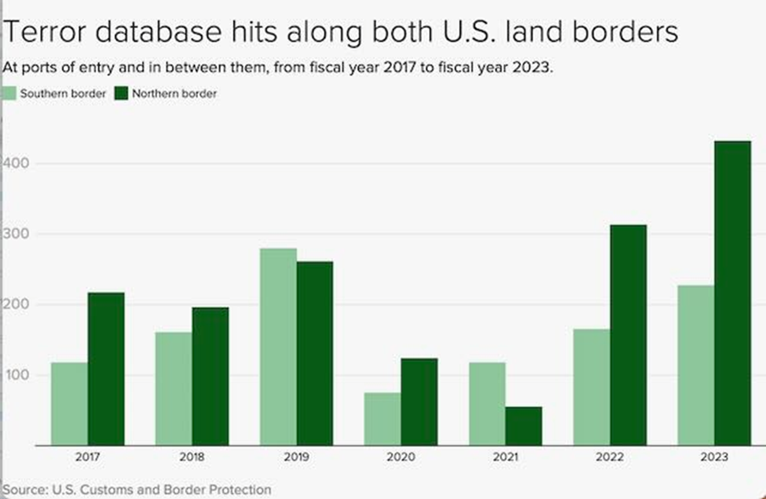
Customs and Border Protection recorded more than 430 watchlist hits along the northern border in fiscal year 2023, the vast majority of them at official ports of entry.
Still, there are concerns. In its homeland threat assessment for 2024, the intelligence branch of DHS said:
“…record encounters of migrants arriving from a growing number of countries have complicated border and immigration security…”
The assessment also said a recent increase in apprehensions of migrants from the Eastern Hemisphere, while still significantly lower than those from the Western Hemisphere, has “exacerbated border security challenges” because those individuals require more vetting and processing and because it’s more difficult to deport them.
There’s also the question of migrants who aren’t apprehended. The Border Patrol estimates more than 1 million individuals have entered the country surreptitiously over the past two years.
Republicans in Congress now talk about the southern border primarily as a national security issue rather than largely as a collective fear of the “great replacement”. If hundreds of thousands of migrants are evading apprehension, these national security fears have merit. But since terror watch list apprehensions are tiny and a lot higher along our northern border, that border most likely poses an equal threat to national security, if not more, since the security along the northern border is lax. We don’t really have any idea how many evade apprehension by crossing it.
Despite the constant hammering by Fox and the Right, since 1975 no one has been killed or injured in a terrorist attack in the US that involved someone who came across the border illegally. Whenever Congress gets around to dealing with illegal immigration, the solution will require more manpower both for the border patrol and immigration services.
Immigrants will keep on coming. Migration is a part of human nature. Europeans came to North America before America was a country. The peoples of the UK are not the peoples that were there 5,000 years ago. The vast majority of UK citizens have little DNA from the original peoples of those islands. That is also true in the US.
History shows that trying to stop immigration all together is a fool’s errand.
Regardless of how successful we are at controlling immigration, the US demographics of the past 250 years will look VERY different from the US demographics of 100 years from now. That doesn’t mean we should give up on controlling the process as much as possible. Part of that is to increase the costs of crossing the border, which we are doing today with instant expulsion and denial of asylum claims.
And once people are here, we must do all we can to get them integrated into US society.
The Daily Escape:

Sunrise, Henry Driggers Park, Brunswick, GA – December 2023 photo by Kyle Morgan
“Dress me up for battle when all I want is peace
Those of us who pay the price come home with the least”
(from 1976’s “Harvest for the World”, by the Isley Brothers)
There are only 11 days left until Christmas, and there are only three more days this year when the Senate is in session, and just two days left for the House. That schedule could be amended and lengthened if both Houses can reach agreement on anything before they break this Friday.
Prime among the legislation that should/must pass is aid for Ukraine. And Ukraine’s president Zelenskyy’s in Washington to try to help turn a few politicians to help. From the WaPo:
“The visit — less than three months after Zelenskyy’s last trip to Washington — comes at a critical time for the supplemental appropriations bill….Republicans have demanded that the package include border policy changes, and some Democrats criticized the White House on Monday for being willing to give up too much in those negotiations after Biden said he was willing to agree to “significantly more” to strike a deal.”
Biden says he’s willing to deal, but Congress seems very likely to leave for the holidays without passing any new Ukraine package. From David Frum in The Atlantic:
“The ostensible reason is that they want more radical action on the border than the Biden administration has offered. The whole aid package is now stalled, with potentially catastrophic consequences for Ukraine. Ukrainian units are literally running out of ammunition.”
More:
“How is any of this happening? On past evidence, a clear majority of Senate Republicans sincerely want to help Ukraine. Probably about half of House Republicans do too. In a pair of procedural test votes in September, measures to cut or block aid to Ukraine drew, respectively, 104 and 117 Republican votes of the 221 (Republicans then) in the caucus.”
Biden’s offer to negotiate with Republicans about the border is meaningful. The fundamental reason for today’s border crisis is that would-be immigrants game the asylum system. The system is overwhelmed by the numbers claiming asylum. Most of those claims will ultimately be rejected, but the processing of each takes years. In the meantime, most asylum seekers will be released into the US.
Biden’s proposal is $14 billion of additional funding that would pay for 1,600 new staff in the asylum system. New hires can speed up the process, reducing the incentive for asylum claimants who get de facto US residency while their claim is pending.
But are Republicans willing to negotiate? It doesn’t seem like they are. The Republicans in the Senate’s position is stated by Sen. John Cornyn (R-TX) who said:
“There’s a misunderstanding on the part of Senator Schumer….This is not a traditional negotiation, where we expect to come up with a bipartisan compromise on the border. This is a price that has to be paid in order to get the supplemental.”
This is 2023: For some Republicans, what matters isn’t what they get, but how they get it.
That’s also true in the House where Speaker Johnson (R-Bible) told Zelenskyy that the US southern border should come first in negotiations with Democrats over aid for Ukraine.
Clearly the Republican House members are in it to strike poses and television hits. They do not want to make deals. They each want to position themselves as the one true conservative too pure for dealmaking. The only things they’re willing to admit they want are the things they know to be impossible.
It’s a complicated situation, because House Republicans have one set of immigration demands while Republicans in the Senate refuse to say what their demands are.
This means Biden has to make a deal that Senate Democrats won’t want. Otherwise we’re headed to a “no” that will doom Ukraine and disgrace the US in the eyes of the world while doing nothing to remedy the crisis at the border.
If Congressional leadership was ever needed, it’s needed today.
Jon V. Last in the Bulwark lists the two real-world reasons for Biden to give in. First, that Ukraine is more important than our domestic immigration policy:
“The war is a finite event, the results of which will influence global economics and security for years and decades to come. Depending on the outcome, NATO will either congeal or fracture. Peace and security in Europe will either stabilize or destabilize. China will either be deterred or encouraged in its quest to subjugate Taiwan.”
Second, immigration is a perennial challenge for America. Even if we “solved” current immigration problems today, next year, we’d have more immigration problems to re-solve:
“Immigration does need reform. Huge sections of the system are broken, the humanitarian crisis at the border is real, and there are some areas where Democrats and Republicans have similar views of which reforms are needed.”
Jon Last also points out that there are good political reasons for Biden to make a deal. First, a deal makes Republicans co-owners of the border problem. For Republicans, immigration is like abortion: It’s not an issue they want to solve; it’s a political club they want to wield.
Second, Biden can paint Republicans as anti-Ukraine even after making an immigration deal. He can say that Republicans didn’t want to fund Ukraine (which polls well with voters) so he had to take action to make sure they didn’t hand Putin a victory.
Third, an immigration deal shores up Biden’s position with Hispanic and swing voters. Immigration is a very important issue to voters and large majorities of them disapprove of Biden’s immigration policies.
Fourth, Biden can then reinforce his 2024 narrative that the election is a choice between governing, or chaos. He’s going to try to disqualify Trump and make 2024 a contest between a workhorse who gets bipartisan compromises done and a chaos agent who burns everything down.
JV Last says:
“Cutting a deal on immigration in order to get aid to Ukraine lets Biden say (a) “I’m the guy who gets business done by doing bipartisan compromise,” but also (b) “If you don’t like this deal, Democratic voters, then we have to win back the House.”
Good thinking from Last.
Wrongo has generally steered clear of debates over immigration and the Wall because they have a high noise to signal ratio, and neither side is always great on the facts.
It’s curious: You would assume that all Republicans should be pounding on their Congressional representatives to increase the number of immigration judges immediately! But they aren’t since that would conflict with their idea of shrinking the administrative state. They shouldn’t be able to have it both ways.
One way to cut illegal immigration down would be to crack down on foreign remittances. Most immigrants are sending money back home to help the rest of their families survive. If remittances required an ID card that only citizens or those with a valid visa could obtain, remittances would fall.
All we can do now is hope for cooler heads to make a deal before year end.
The Daily Escape:

Garden of The Gods, CO – December 2023 photo by James H. Egbert
It’s another Monday, and the world is still a mess. There is so much division here at home that we forget that the rest of the world is boiling over with wars. Not a world war, but there are wars everywhere around the world. Americans are focused on the Ukraine War and the Israel/Hamas war, but there are local and regional wars we barely hear about.
From Hal Gershowitz:
“Among the deadliest wars so far in this still young century are the Second Congo War, the Syrian Civil War, the Darfur War in western Sudan, the war in Afghanistan following the attacks on the World Trade Center on September 11, 2001, the war against Boko Harem in Nigeria, the Yemeni Civil War, Russia’s current war against Ukraine, and, of course, the current blood-letting between Israel and Hamas.”
More:
“According to the Geneva Academy….more than 110 armed conflicts are raging worldwide.”
Gershowitz says that in 2022, 237,000 men, women, and children died from organized violence, double the number of armed conflict deaths of the year before. While the bloody toll for 2023 hasn’t been compiled yet, we should expect the numbers to exceed those of 2022.
The Middle East, including North Africa, is the most blood-soaked region of the world, hosting more than 45 shooting wars. We know about the Israel/Hamas fight, but we hear much less about ongoing armed conflicts in Cyprus, Egypt, Libya, Morocco, Syria, Turkey, Yemen and Western Sahara.
There are scores of other active hot conflicts, most of which don’t ever make headlines: Burkina Faso, Cameroon, Central African Republic, Democratic Republic of Congo, Ethiopia, Mali, Mozambique, Nigeria, Senegal, Somalia, South Sudan and Sudan are among the most dangerous places on the planet for civilians.
War dead in this region alone adds up to between hundreds and thousands every day. Some countries, such as the Central African Republic, have had multiple wars. Last year, the war in Ethiopia’s Tigray region accounted for over 100,000 battle-related deaths, according to Oslo’s Peace Research Institute.
Currently, there are 21 separate armed conflicts raging in Asia, two of which are considered international wars (India-Pakistan and skirmishes between India and China). In some countries, such as Pakistan and the Philippines, there are multiple armed conflicts taking place simultaneously. Both countries are host to six separate regional in-country conflicts.
While everyone is familiar with Putin’s war in Ukraine, there are five other European nations (or territories) that Russian armies have occupied, including Ukraine’s Crimean Peninsula, Moldova’s Transdniestria, South Ossetia, and Abkhazia (Georgia).
The deaths in Ukraine are adding up. The US estimated in August that there were approximately 300,000 Russian casualties, including as many as 120,000 deaths and 180,000 wounded. Ukrainian losses were estimated at 70,000 deaths and 120,000 wounded. Since those estimates were released, the toll of dead and wounded on both sides has climbed even higher.
In our hemisphere, there are six armed conflicts in Latin America—three in Mexico and three in Columbia.
The 21st Century is still young, but it’s horribly violent. China is eyeing Taiwan, North Korea is elbowing its way into the nuclear club, and Iran, which follows the Shia form of Islam, is eying all of Arabia, which embraces Sunni Islam.
Back to Israel/Hamas for a few random thoughts: First, at the start of any new armed conflict, the UN, occasionally the US and other nations, call for an immediate cease fire. There hasn’t been a durable cease fire in this century. Yet, Steve Coll in the New Yorker had this to say:
“Even a temporary ceasefire displays the moral power of peacemaking. Last week, as a shaky truce to allow prisoner and hostage swaps and aid deliveries quieted the ruinous war between Israel and Hamas, Israeli families welcomed back more than a hundred children and older adults whom Hamas and its allies had kidnapped on October 7th…..In the West Bank, jubilant crowds waved the flags of Fatah and Hamas as Palestinian parents hugged their teen-age children released from Israeli jails.”
More:
“Ceasefires usually don’t end wars because they don’t address the issues that underlie them. (A study of sixty-seven civil wars published in the Journal of Peace Studies in 2021 found no evidence that ceasefires and prisoner releases led to sustainable peace agreements.)”
Specifically with respect to Israel/Hamas, we can’t see what the end state looks like. Netanyahu visited Gaza during the ceasefire and cited three aims: “eliminating Hamas, returning all of our hostages, and insuring that Gaza does not become a threat to the State of Israel again.”
As Wrongo said two months ago, it is difficult to see how the second objective can be achieved in tandem with the first. Regardless of what Netanyahu thinks, the third will not be controlled by Israel, even though it may be the most important of Israel’s three objectives.
Another problem is that this war is causing a terrible divide in America. Think about how quickly U of Penn’s president Liz Magill was forced to resign after giving a truthful and legally correct answer to an utterly bad faith question. The question she was asked was, “Is calling for the genocide of Jews always a violation of Penn’s code of conduct in regard to bullying and harassment?”
Now, no rational person is in favor of genocide, but Rep. Stefanik’s question implies that simply speaking out in support of Palestinians is the equivalent of calling for Jewish genocide. Plenty of today’s college students support Palestine, and very few of them think that Jews should be exterminated.
Stefanik’s question asks us to ignore people’s free speech rights when they are awful and noxious. It lands very close to the witch hunting of McCarthyism in the 1950s.
Also, it’s clear in Wrongo’s circle that people are afraid to express opinions on the Israel/Hamas war, because whatever is said is sure to offend someone. It could possibly be enough to cause a threatening retaliation. What’s worse is that not a single person will live or die in the Middle East because of anything anyone says or doesn’t say at the University of Pennsylvania or in Wrongo’s hometown.
There is nothing at stake in the performative rage about what’s said at college demonstrations. It’s all empty theater.
Time to wake up America! If Republicans and other hardliners are able to make criticism of Israel a forbidden topic in mainstream society, that means our democracy will die right along with the many more deaths we will see in the Middle-East.
To help you wake up, watch and listen to a globally produced cover of Marvin Gaye’s “What’s Going On” by the people behind Playing For Change. This song came out in 1971 when the Vietnam war was still going on. Here it features Sara Bareilles among many other talented people:
Sample lyric:
Father, father
We don’t need to escalate
You see, war is not the answer
For only love can conquer hate
You know we’ve got to find a way
To bring some loving here today…
The Daily Escape:

Wild surf, Shore Acres SP, OR – December 2020 photo by Alan Nyri Photography
Instead of a soothing Saturday, Wrongo has decided to wade into the hot steaming pile that is the controversy over whether the presidents of various prestige universities are sufficiently anti-genocide. What they said at the House hearings has raised a chorus of voices who think that the leadership at Harvard, MIT and UPenn just aren’t anti-genocide enough.
From Bloomberg’s Noah Feldman:
“The lowlight of the House hearings on campus antisemitism…came when Congresswoman Elise Stefanik (R-NY) asked the presidents of Harvard, MIT, and the University of Pennsylvania whether it would be bullying and harassment if someone on campus called for a genocide of Jews. The presidents’ answers — that it depended on context — landed about as badly as it could have. Stefanik, a Trumpist Republican election denier, browbeat them and called it “unacceptable.”
Feldman is a law professor at Harvard. He went on to say:
“The core idea of First Amendment freedom is that the expression of ideas should not be punished because doing so would make it harder, not easier, to find the truth. That freedom extends to the most hateful ideas imaginable, including advocacy of racism, antisemitism, and yes, genocide.”
Wrongo isn’t a lawyer and this isn’t a court or a classroom, so what follows is his take on this matter.
Can speech be constrained? In 1969, the Supreme Court protected a Ku Klux Klan member’s speech and created the “imminent danger” test to determine on what grounds speech can be limited, saying in Brandenburg v. Ohio that:
“The constitutional guarantees of free speech and free press do not permit a state to forbid or proscribe advocacy of the use of force, or of law violation except where such advocacy is directed to inciting imminent lawless action and is likely to incite or produce such action.”
Speech promoting violation of the law may only be restricted when it poses an imminent danger of unlawful action, where the speaker has the intention to incite such action, and there is the likelihood that this will be the consequence of that speech.
In 2017, the Court affirmed this in a unanimous decision on Matal v. Tam. The issue was about government prohibiting the registration of trademarks that are “racially disparaging”. Effectively, the Supreme Court unanimously reaffirmed that there is no “hate speech” exception to the First Amendment. Such speech can be prohibited when the very utterances inflict injury or tend to incite an immediate breach of the peace.
There is plenty of case law on the First Amendment out there to read or about hate speech if you prefer to do your own research. From Wikipedia:
“In the 1980s and 1990s, more than 350…universities adopted “speech codes” regulating discriminatory speech by faculty and students. These codes have not fared well in the courts, where they are frequently overturned as violations of the First Amendment.”
So, while University presidents may sound lawyer-like when asked if “calling for genocide of Jews” should be prohibited, think about the long history of case law that says there are few limits on hate speech that do not result in action intended to produce harm. Also think about the losing streak these universities have been on when they have tried to restrict speech in the past.
As it happens, the three presidents were accurately describing their universities’ rules, which do depend on context. Yascha Mounk in The Atlantic had this to say:
“In a narrow, technical sense, the three presidents were correct to state that their current policies would probably not penalize offensive political speech. In a more substantive sense, universities should defend a very broad definition of academic freedom, one that shields students and faculty members from punishment for expressing a political opinion, no matter how abhorrent.”
Mounk goes on to say that the university presidents were disingenuous when they claimed that their response to anti-Semitism on campus was hamstrung by a commitment to free speech. Recent history at all three institutions shows that their rules about free speech are unevenly applied. So the problem with their answers wasn’t about making a judgement call about calls for genocide.
We’re stepping into muddy waters here. When students say: “From the river to the sea. Palestine will soon be free” they’re using a political slogan that on its face is aspirational. While some may hear that and say it implies genocide of Jews, it should be protected speech. It’s stupid and ignorant, but 100% protected. Widening out our view, blaming all Jews for Netanyahu’s excesses or blaming all Palestinians for the atrocities of Hamas is wrong but it’s still protected speech.
People like Stefanik are too high on their own agenda to appreciate the distinction.
Still, it’s true that many (most? all?) universities have become hypocritical. There are plenty of examples of professors being expelled, or outside speakers being cancelled because the administration doesn’t care for the viewpoints being expressed.
The question of exactly when political/hate speech becomes sufficiently threatening and specific toward a given individual or groups so as to constitute legally (and by extension administratively) a violation of a university’s code of conduct is, not surprisingly, a massive gray area. On Thursday a man saying “Free Palestine” fired shots at a synagogue near Albany NY. Thankfully, nobody was harmed. He wasn’t on campus and he did back his words with a serious threat, so he was arrested.
The university presidents failed to be clear. The US case law and the school’s codes of conduct are sufficiently difficult to adjudicate on a hypothetical basis. These three presidents should learn that first, the US Congress isn’t the academy. Second, they should admit they are fuzzy thinkers about free speech at their institutions. Third, they should develop better codes of conduct.
Let’s give the last word to Feldman:
“Free-speech nuance is something to be proud of, not something to condemn.”
A final thought. Stefanik’s gotcha game with yes/no answers to complex questions shouldn’t be the way the game is played, but for now it is. Many Republicans think that colleges and universities deserve specific blame for the liberal political views of young Americans. It has become an article of faith on the right despite little supporting evidence that colleges are turning young people into liberals. Stefanik is a willing tool of this viewpoint.
On to our Saturday Soother. We’ve had snow overnight for the past two days on the Fields of Wrong. Still, it’s expected to be around 60° on Sunday. Given our uneven weather, the arborist isn’t coming here until the middle of February.
Let’s get comfortable in a big chair near a window. Now, try to let go of the arguments about the “people we hate and I want to talk about them” and empty our minds of complicated ideas, even if they are foundational to our democratic experiment.
Let’s listen to the Academy of St. Martin-in-the-Fields Chamber Ensemble perform Maurice Ravel’s “Introduction and Allegro for harp, flute, clarinet and string quartet”. He composed this work in 1905 and it was first performed in 1907.
The Daily Escape:

First snow, Doubling Point Lighthouse, Kennebec River, ME – December 2023 photo by Rick Berk Photography
Wrongo may have stumbled upon the reason why people say the economy is bad when so many economists say it isn’t. From a LendingClub report from last May: (emphasis by Wrongo)
“For some Americans, earning a six-figure income doesn’t guarantee a comfortable lifestyle….many Americans are struggling to make ends meet — with 61% of those surveyed saying they feel stretched too thin, and 49% of those earning $100,000 or more saying they’re living paycheck to paycheck.”
This ties together with other information, some of which comes from the issue, who reported this from the Aspen Institute: (emphasis by Wrongo)
“Though routinely positive cash flow is the starting point for financial stability, it remains largely out of reach for many Americans. Even before the fallout of the COVID-19 pandemic, nearly half (46.5%) of households reported that their income did not exceed their spending over the course of a year. For households with annual income of less than $30,000, this number increases to three in five (61.5%).”
Now there may be many reasons why people spend beyond their means. Some seem to be unable to defer gratification until there’s money in the bank, so they buy on credit. There was a $48.5 billion jump in spending from September to October 2023. For others who make less than a living wage, the problem isn’t one of choice, it’s existential.
The searing takeaway from the above is that negative personal cashflow was a problem even before the post-Covid inflation drove prices through the roof in America. The Aspen Institute provides this handy chart showing how individuals build financial security:
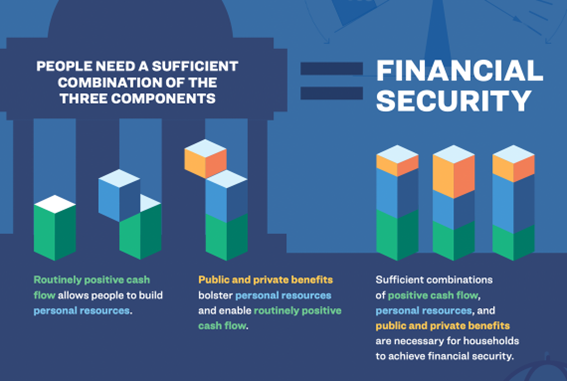
Financial security starts with having a routinely positive cashflow. But, nearly 50% of Americans today aren’t cash flow positive (see quote above), while 49% of people earning more than $100k are living paycheck to paycheck.
This dovetails with Wrongo’s Monday column which showed that “Nearly 3 in 10 Americans say they have had to forgo seeing a doctor in the past year due to costs.” If you’re one of the 7.5% of uninsured Americans, and have money in your checking account that isn’t going to necessities, you can definitely go to the doctor.
Aspen has another chart that shows the breakdown of who lives paycheck to paycheck by income levels:
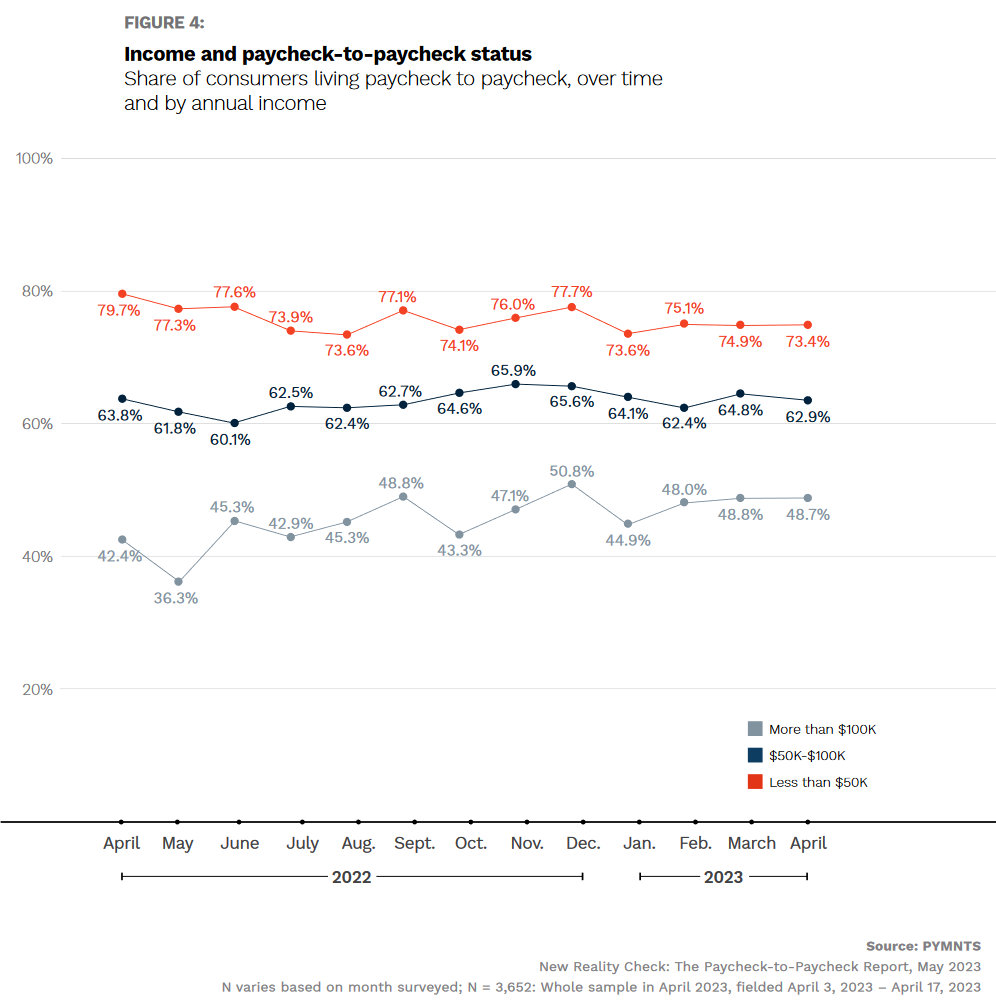
Seventy-four percent of those making less than $50k are living paycheck to paycheck, and while the percentage gets smaller as annual income rises, it’s still 48.7% for people making more than $100k, in an economy where the median income is around $54K! FYI, the percentage of Americans who make $50k or less is 37.8%.
More from LendingClub: (brackets and emphasis by Wrongo)
“The share of consumers in the US earning over $100,000 per year who live paycheck to paycheck increased 7 percentage points in April year over year. High-income consumers are particularly likely to live in urban areas, at 36%, and these tendencies toward higher incomes…[don’t] prevent almost 70% of urban dwellers from saying they live paycheck to paycheck.”
It’s hard not to conclude that the majority of Americans are currently experiencing dire financial conditions, including many who live with negative cashflow. When your cashflow is negative, you either cut back, borrow or sell assets. For most people selling assets isn’t a real choice. So while some cut back, the majority borrow to make ends meet. According to the issue, the:
“…highest risk, and most expensive forms of debt are now growing fastest. Payday loans, online insta-loans, and so forth. That means that people are exhausting the more mundane forms of debt—credit cards, bank loans, government loans, etcetera.”
This squares with a report by Achieve, a personal debt management firm, that shows:
“In the first nine months of 2023, the average monthly participation in debt resolution programs increased by 119% compared to 2020, even though the average earnings rose by approximately 37% during the same period.”
It gets worse:
“In 2023, the typical household income of individuals enrolled in debt resolution programs was $59,900, which is a notable increase from $43,598 three years prior.”
Americans are earning 37% more but are still struggling with debt. Not a pretty picture to take before the voters.
Meanwhile, Democrats still are touting how “strong” the economy is. The aggregate numbers hide terrible personal experiences that are happening out of sight of our politicians and surprisingly, our economists. However, it’s clear from the polls that few Americans are buying that message apart from the true believers, the media and pundits.
The disconnect between economic data and the lived experience of average people needs to be addressed by Biden and the Democrats. If nothing is done to at least acknowledge the actual problems of many Americans specifically, their negative personal cashflow, these angry folks will certainly tilt toward giving Trump another chance.
Let’s give the issue the last word:
“What is this? What do we call it when the majority of people can’t make ends meet, as in, they’re literally spending more than they make, because they don’t make enough to live a stable or secure life?
Today the averages are hiding a truth: that a near-majority of American citizens are financially underwater. These are big numbers. The Census Bureau says as of now, 258.3 million Americans are adults. And the Aspen Institute says that 46.5% of them can’t make ends meet. That’s 120 million of us that are going deeper in debt every month.
That can only happen when those at the very top are skimming off more than 100% of the growth in the economy. This suggests that Biden et al need to run on policy that will help the majority of voters, not simply the moneyed people who finance political campaigns.
The Daily Escape:

Cypress trees, Lake Verritt, LA – November 2023 photo by Rick Berk Photography. Note the egret in the background.
For today’s Wake Up Call, we return to a staple of yesteryear, some hot links that caught Wrongo’s eye over the past few days.
Wrongo isn’t happy with how the Ukraine War has slipped from the consciousness of America’s media and thereby, from our view. Saturday’s WSJ offered an intriguing idea with its column, “Does the West Have a Double Standard for Ukraine and Gaza?” (free link). The article makes two excellent points. First, how these two wars have divided the world. Here’s a view of the division:
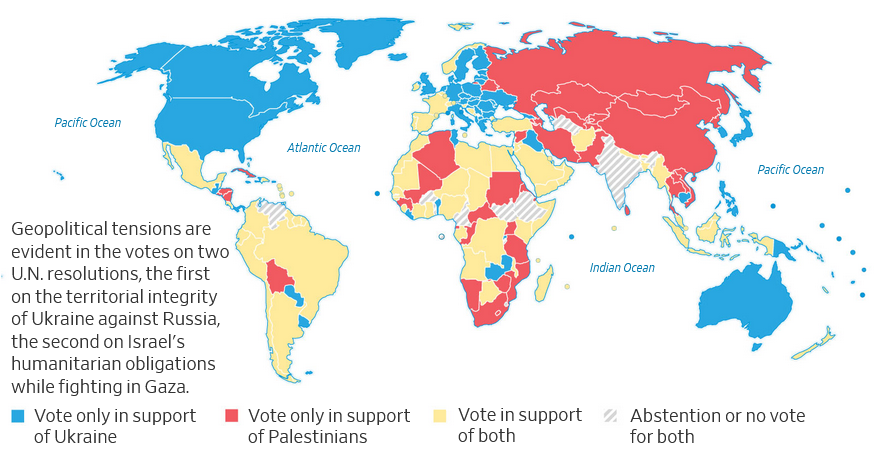
From the WSJ: (emphasis by Wrongo)
“Outrage and political mobilization have become subordinated to geopolitical allegiances—a selective empathy that often treats ordinary Ukrainians, Palestinians and Israelis as pawns in a larger ideological battle within Western societies and between the West and rivals such as China and Russia.”
Second, the article concludes by saying that the main difference between the two wars is that the Israeli-Palestinian conflict, with all its complexities, lacks the moral clarity of the Ukrainian resistance to Russia. They quote British lawmaker Alex Sobel:
“There is no moral justification for the Russian invasion. Zero. It’s just about Russian imperialism….But in Israel and Palestine, it’s about the fact that there are two peoples on a very small amount of land, and political and military elites on both sides are unwilling to settle for what’s on offer.”
Yes, America may have the moral high ground in both cases, and views can differ on how both wars are being waged. But as the article says in its second paragraph:
“The Russian invasion of Ukraine in February 2022 was unprovoked, while Israel sent troops into Gaza because of a mass slaughter of Israeli civilians…”.
Make of the article what you will, but it’s important to think through why you (like Biden) think both wars are morally equivalent.
Link #2 is apropos of the COP28 conference now underway in Dubai. Grist Magazine has an article: “Where could millions of EV batteries retire? Solar farms.” As solar energy expands, it’s becoming more common to use batteries to store the power as it’s generated and transmit it through the grid later. One new idea is to source that battery back up at least in part from used electric vehicle batteries:
“Electric vehicle batteries are typically replaced when they reach 70 to 80% of their capacity, largely because the range they provide at that point begins to dwindle. Almost all of the critical materials inside them, including lithium, nickel, and cobalt, are reusable. A growing domestic recycling industry, supported by billions of dollars in loans from the Energy Department and incentives in the Inflation Reduction Act, is being built to prepare for what will one day be tens of millions of retired EV battery packs.”
More:
“Before they are disassembled…studies show that around three quarters of decommissioned packs are suitable for a second life as stationary storage.”
Apparently there are already at least 3 gigawatt-hours of decommissioned EV battery packs sitting around in the US that could be deployed, and that the volume of them being removed from cars is doubling every two years.
Link #3 also shows the impact of the Inflation Reduction Act. Wolf Richter writes that:
“In October, $18.5 billion were plowed into construction of manufacturing plants in the US ($246 billion annualized), up by 73% from a year ago, by 136% from two years ago, and by 166% from October 2019.”
More:
“The US is the second largest manufacturing country by output, behind China and has a greater share of global production than the next three countries combined, Germany, Japan, and India.”
All of this construction spending will take time to turn into production. When these new plants are up and running and producing at scale, manufacturing’s share of US GDP will rise. And much of the new construction is happening in fly-over America, which can use the help.
Finding factory workers in sufficient numbers to support the new capacity will be a key. America has energy in abundance and has robotic manufacturing. So pulling production from overseas with fewer workers needed will be a giant plus for the US.
Link #4 is a downer. Civic Science says in this week’s 3 things to know column, that “Nearly 3 in 10 Americans say they have had to forgo seeing a doctor in the past year due to costs.” Here’s their chart”:
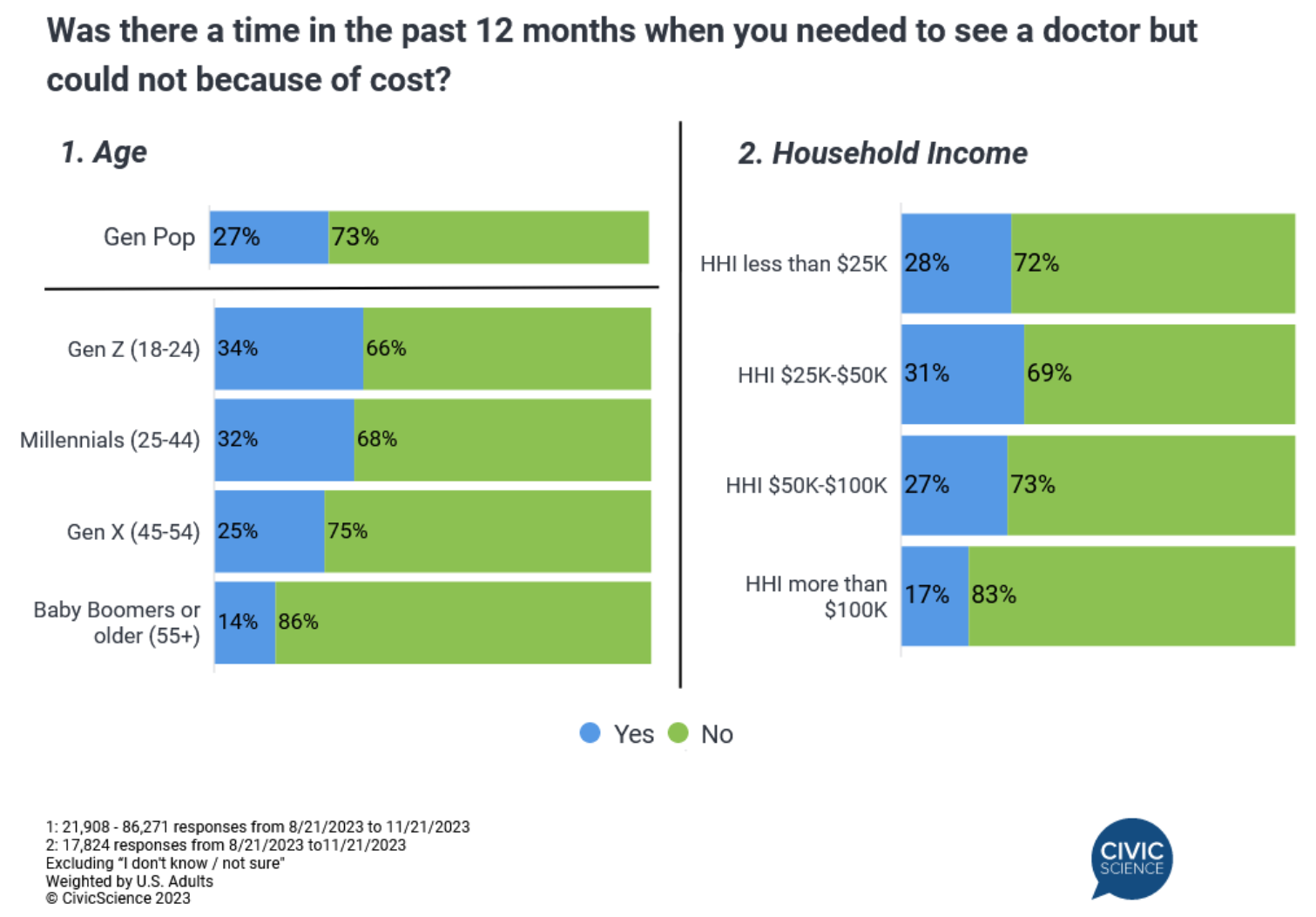
Civic Science says that 12% of US adults have had to miss or make a late payment on medical bills in the last 90 days, a two percentage point increase over September 2022.
A far larger percentage of Americans – 27% of the general population and about 30% of respondents under 55 years old or with an annual household income under $100,000 – report they could not go to a doctor in the past 12 months because they could not afford the cost. Gen Z adults and households making between $25K-$50K are more likely to have held off seeing a doctor due to cost (34% and 31% respectively).
We all know that medical costs have continued to rise and that medical debt is the leading cause of personal bankruptcy in the US. If Congress was really interested in helping provide for the general welfare, they would deal with this out of control problem.
Time to wake up America! There’s plenty going on that isn’t getting visibility in the mainstream media or on social media. You have to cast your net widely to be on top of the good and bad happening in the US.
To help you wake up, we turn to Shane MacGowan, frontman for the Irish group the Pogues who died last week. He left behind a body of work that merged traditional Irish music and punk rock. He wrote many songs that could easily be mistaken for traditional Irish tunes including this one, which was also used as the music for wakes by the Baltimore Police Department in the great, great HBO series, “The Wire“. Here’s “The Body Of An American” from their 1986 album, “Poguetry in Motion”:
RIP Shane.
The Daily Escape:

San Juan river cuts through monocline ridge, UT – November 2023 drone photo by Hilary Bralove. It is believed by many that the Navajo people based their rug and basket weaving patterns on what they saw in these geologic formations.
The temporary truce in the Israel/Hamas war is over. Reprobate Congresscritter George Santos (R-NY) was ousted from the House, and former Supreme Court Justice Sandra Day O’Connor died. She was the swing vote in the Bush v. Gore case that stopped the Florida recount and handed the 2000 presidential election to GW Bush. This was the first time that Republicans realized that if they controlled the Court, they could fix elections.
But on a pretty Saturday in southern New England, let’s turn our attention to a news article that hasn’t gotten much interest. From the issue, we learn that:
“More people died from suicide in the United States last year than any other year on record, dating to at least 1941, according to provisional data from the US Centers for Disease Control and Prevention.”
They quote the Kaiser Family Foundation who measure the suicide deaths per 100,000 of population: (brackets by Wrongo)
“Suicide deaths are increasing fastest among people of color, younger individuals, and people who live in rural areas. Between 2011 and 2021, suicide death rates increased substantially among people of color, with the highest increase among AIAN people [American Indian and Alaska Native people] (70% increase, from 16.5 to 28.1 per 100,000), followed by Black (58% increase, from 5.5 to 8.7 per 100,000), and Hispanic (39% increase, 5.7 to 7.9 per 100,000) people….The suicide death rate also increased in adolescents (48% increase, from 4.4 to 6.5 per 100,000) and young adults (39% increase, from 13.0 to 18.1 per 100,000) between 2011 and 2021….”
Suicide rates are up by nearly 50% in adolescents over the last decade, while suicides among Black people are up by almost 60%. These aren’t trends, they’re explosive changes. What we’re seeing in the data is our world in chaos.
Wrongo often says that American life has fallen apart over the past 30 years. People struggle to pay their bills; many do that by accumulating debt. For some, that struggle turns them to embrace demagogues, people who scapegoat innocents, or promise to take their rights away, robbing them of their personhood.
When we see suicide rising particularly among groups who struggle the most for their existence, it says that something has gone terribly wrong with the American model. And in the suicide statistics, there is confirmation that our nearly Darwinian model is what’s wrong. Adolescents and minorities aren’t committing suicide at these rates because they can’t get therapy, but because they feel as if there’s little or no future for them. Sadly, they are told by many pundits and politicians that everything’s fine.
Perhaps this partially explains why Biden seems to be doing so badly in polls of young voters.
As one of the commenters at the issue says:
“It shouldn’t be ‘The pursuit of happiness’ it should be ‘The amelioration of misery’. Being free to pursue happiness when there isn’t enough…left to go around doesn’t do ‘We the people’ any good.”
So, it’s time to forget about Santos, Kissinger and Hamas for a few minutes. Tune in to your Saturday Soother, where we try to get distance from the news for long enough to be able to handle whatever’s coming next.
Here on the Fields of Wrong, we’ve completed our fall clean-up and now it’s on to putting up the deer fencing that protects the bushes around the Mansion. The tree is up and illuminated, and the first members of our family are coming to see it today.
While it’s a beautiful day in the northeast, it makes sense for you to stay indoors for now. Start by brewing up a mug of “The Antidote” coffee ($19.50/12oz.) from Apocalypse Coffee in Melbourne, FL. Now grab a comfy chair by a south facing window and watch and listen to Schubert’s “Serenade”. Written two years before his death, it’s a perfect example of the melancholic music Schubert was so well known for:
The Daily Escape:

Camden, ME – November 2023 photo by Daniel F. Dishner. Note the star: It’s on top of nearby Mt.Battie.
Kissinger may have changed the world, but that isn’t always a good thing. The media are calling his legacy “complicated”. For Wrongo, it isn’t complicated. He may have gotten Nixon to China and negotiated (?) the end of the war in Vietnam, but his time on our foreign policy stage is strewn with death and destruction. Think about the carpet bombing of Cambodia that led to the demonstrations against the war in May 1970 and to the murders at Kent State and Jackson State University. Think about the coup in Chile that overthrew Salvador Allende.
Now, Nixon’s entire Cabinet is dead.
Kissinger’s philosophy was to look at “the big picture”. He was gladdened by how his China diplomacy rattled the Soviets. Most of Wrongo’s current thinking about Kissinger comes from reading Christopher Hitchens’ 2001 book, “The Trial of Henry Kissinger”. Hitchens talks about Kissinger’s role in the destruction of Chilean democracy in favor of the Pinochet dictatorship. And when Pinochet ordered the assassination of dissenter and former U.S. ambassador Orlando Letelier on US soil by blowing up his car in Washington, Kissinger was fine with that.
He was responsible for the prolongation of the Vietnam War through the sabotage of Lyndon Johnson’s 1968 Vietnam peace talks along with the civilian deaths from the US’ bombing in Laos and Cambodia, helping to usher in the Khmer Rouge, while also not doing anything positive to win the Vietnam war. Kissinger then became supportive of the Khmer Rouge. He saw its leader, Pol Pot as a counterweight against North Vietnam. He asked Thailand’s foreign minister to tell the Khmer Rouge: “We will be friends with them. They are murderous thugs, but we won’t let that stand in our way. We are prepared to improve relations with them.”
That was Kissinger’s moral philosophy.
Kissinger was behind the Greek military junta’s invasion of Cyprus in 1974, and the Pakistani army’s crimes against humanity in East Pakistan (now Bangladesh). And we shouldn’t forget the Indonesian invasion and subsequent destruction of East Timor.
Quite the record for a Nobel Peace Prize Laureate.
Late in life. Kissinger continued supporting authoritarians including Putin. Kissinger intervened in Putin’s imperialist war in Ukraine in 2022 to support the idea that the West should bully Zelensky into giving up territory to the Russians. He was also on the board of Theranos helping to facilitate the fraud while lining his pockets.
Wrongo wrote earlier this year about how he started out as a Kissinger fanboy, having read his 1957 book “Nuclear Weapons and Foreign Policy” while in high school. It criticized the Eisenhower Administration’s “massive retaliation” nuclear doctrine. It proposed the use of tactical nuclear weapons on a regular basis to help win wars. By the time that Wrongo was running a tactical nuclear missile base in the mid-1960s, he was no longer a fan. From Wrongo:
“Wrongo met Kissinger in the mid-1980s at an event hosted by David Rockefeller at his Pocantico Hills estate. HK was walking his dog, a particularly obstreperous Golden Retriever. Wrongo asked “What’s the dog’s name?” Kissinger replied: “Madman”. Could there be a more perfect name for a Kissinger family pet?”
Here are a few headlines announcing Kissinger’s death:

You’ve gotta love the Rolling Stone headline.
Kissinger’s legacy is defined by his role in the US’s resumption of ties with China. He did the groundwork for Nixon’s 1972 visit to China and made more than 100 trips to the country over the years. The WaPo noted that the China state broadcaster labeled Kissinger an “old friend of the Chinese people.”
Let’s close with another possibly apocryphal story about Kissinger by Corey Robin:

Let’s hope that Henry the K is having a really hot time in his new condo.